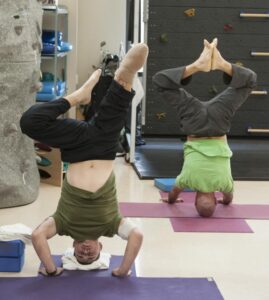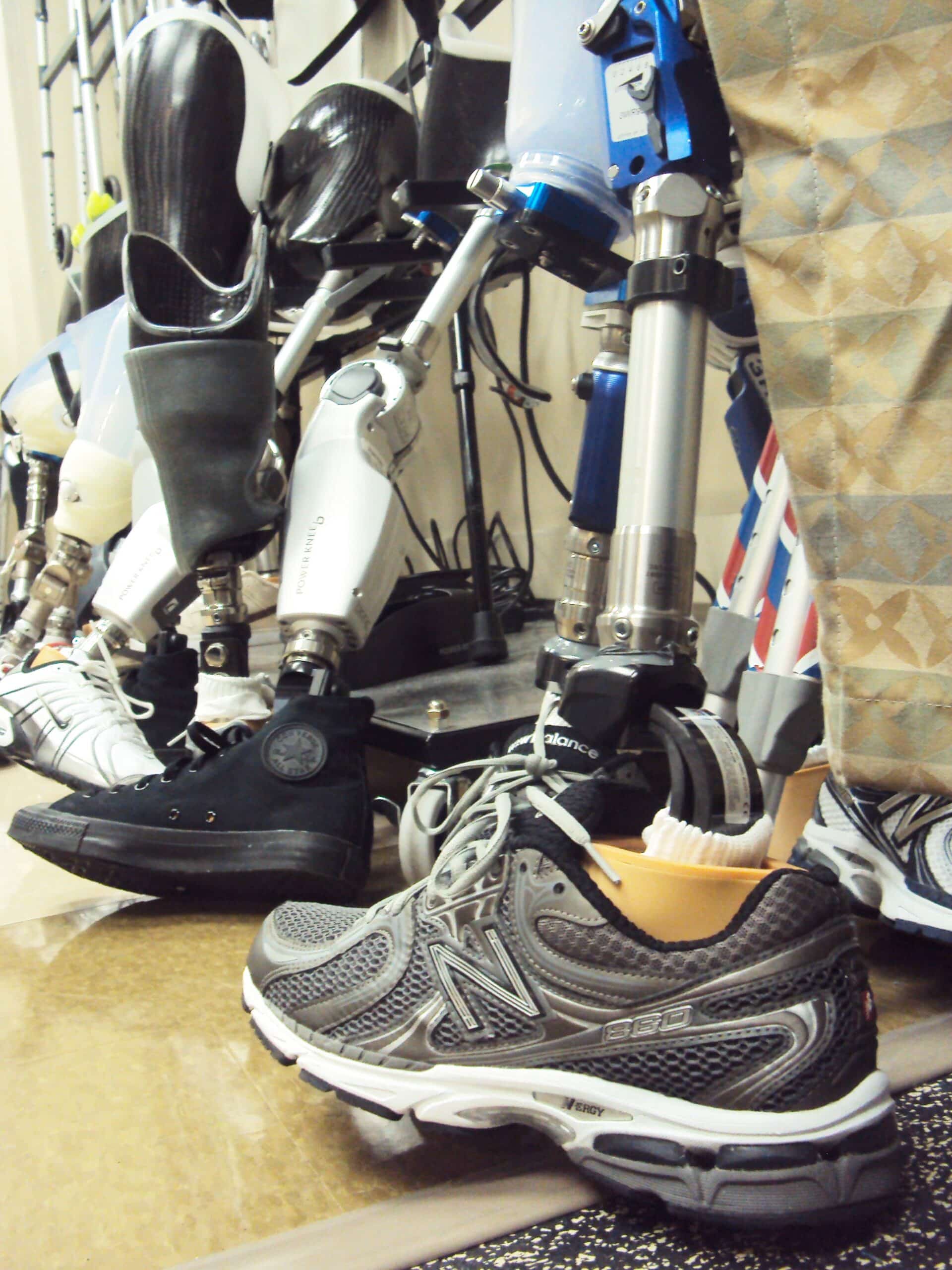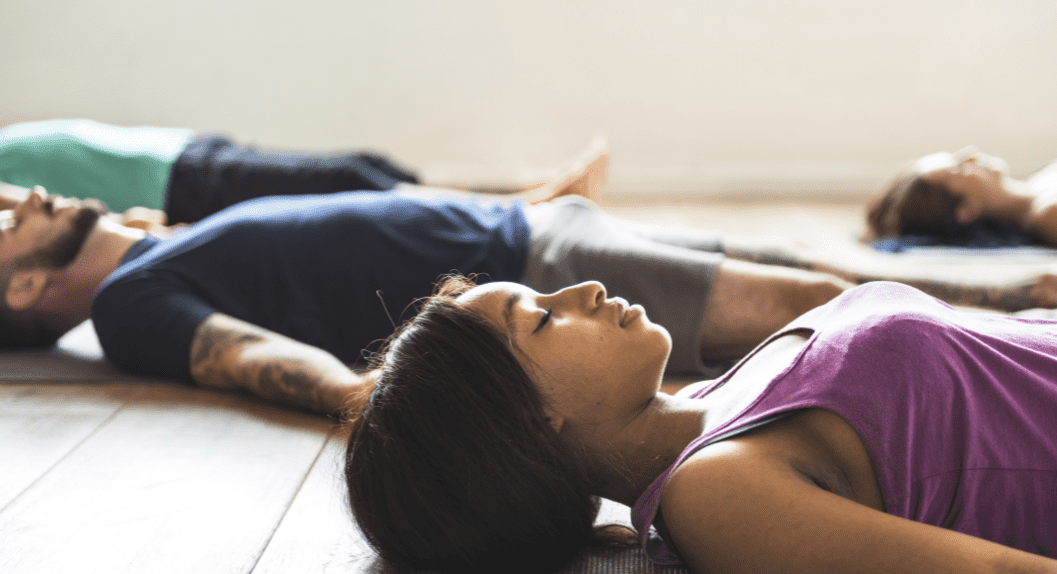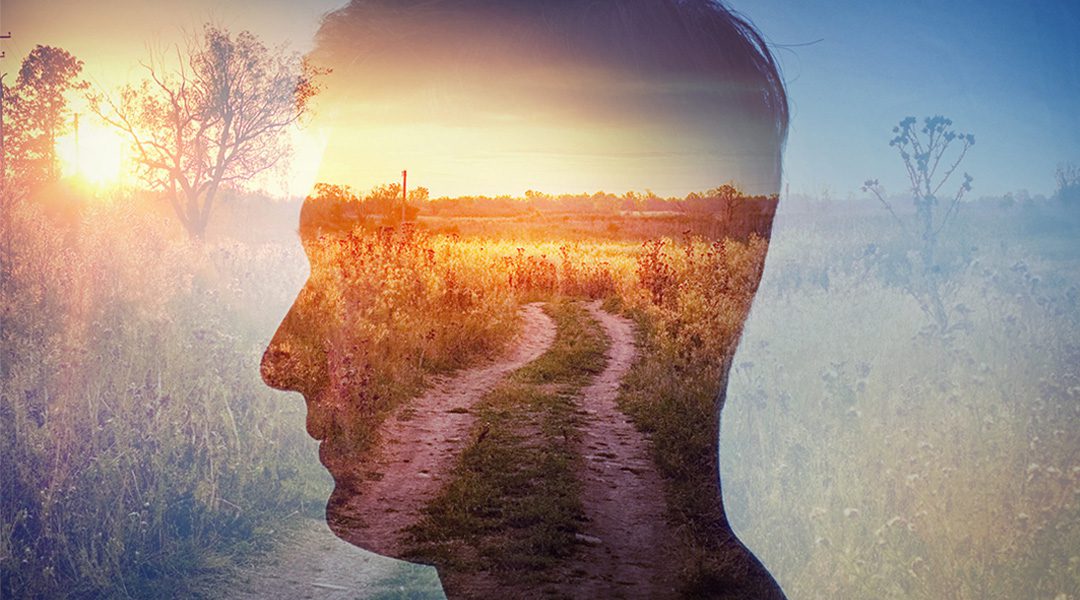Q&A with Daniel Hickman, E-RYT 500, YACEP
After returning from combat, many military veterans are being introduced to Yoga and meditation practices to help address the physical, mental, and emotional effects of warfare and trauma. Yoga teachers like Daniel Hickman are sharing these healing practices with the military community, including service men and women, veterans, and their families. A son of a veteran, Daniel has been teaching meditation and adaptive yogic practices for over eleven years in the Military Advanced Training Center (MATC) at the Walter Reed National Military Medical Center (WRNMMC) in Bethesda, Maryland. In the following interview, Daniel shares his challenges and rewards on the journey, his approach to teaching, and his understanding of the warrior archetype.
Please note: This article contains references to warfare-sustained injuries that may be triggering for some readers.

A veteran practices headstand in Daniel’s class.
In your work, you address the effects of warfare with Yoga and meditation. What are some of the biggest challenges and greatest rewards?
Within the first two years of working within the military medical community, one of the challenges I encountered was a bit of reluctance from the community to have someone there teaching yogic practices, especially because of the specific injuries that a lot of people were coming back with, which included being blown up by bombs, shot up by rockets, terrible crashes, and such. So there was a little skepticism about how pranayama (breathing exercises), asana (postures) and meditation might actually help out. It took about two years before I felt that I was a little more accepted into the community. I stuck it out and it has been eleven years now. Since then, the most challenging thing, I would say, is the almost constant interruption and the noise. My classes are not in an enclosed space; they are actually in the middle of the floor right next to the occupational therapy section, which is right next to the physical therapy section. It’s basically a hospital, and you have a lot of patients that are coming and going, as well as therapy dogs, celebrities that stop by, politicians, and generals; so many people are coming and going.
At one point I was asked if I would like to go to another space in the hospital that is closed off, and I said no. I felt that it might have killed the program because it would be tucked away and out of sight. I decided it should stay out in the open because of the reluctance of the warrior class to try Yoga and the stereotype that something yogic or meditative is passive, weak, ineffective, or pointless. By keeping the class in a public space, people could see what was going on and they could actually glean off of it just from observing it.
So, because the class was out in the open in the hospital, those who weren’t taking the class could walk by and watch what was taking place?
Yes. So here is one example: there was one guy in a wheelchair who had a single, below-the-knee amputation, and he had some damage in other areas of his body. Most combatants with similar injuries may also have TBI (traumatic brain injury) and probably PTSD (post-traumatic stress disorder). He would watch and watch and watch us, but he wouldn’t bother with coming to class. I used to ask people if they’d like to join the class, but I don’t ask anymore because I know they already see it and know about it. Often during class, this guy would wheel up his chair close to where we were practicing. He could barely be seen, but he was close enough to hear what I was saying. One time I was leading deergha pranayama (3-part breathing) and I looked at him out of the corner of my eyes and saw that he was practicing the pranayama in his wheelchair. That was probably one of the biggest rewards; it let me know that the perseverance and the continuance of the Yoga sadhana right there in the middle of the military medical community was actually being felt by people who weren’t necessarily comfortable enough to join in, but probably knew that it would help them out. I don’t think I ever saw that man again, and I don’t know if he ever went on to practice Yoga, but it was a seed planted, I like to think.
Many veterans have encountered some kind of trauma in their service. What role does trauma-informed practice have in the work that you do?
First, I’d just like to clarify that I’m not a psychotherapist, psychiatrist, or a licensed social worker; I’m not a clinician and I’m not a doctor, but I have studied quite a lot about trauma. I work alongside these professions, and I have gleaned a lot of information by rubbing shoulders with these individuals, as well as from working in some specific programs that have included deep work with those suffering from PTSD. What I’ve learned is that trauma is a very layered thing.
I am a son of a veteran, and that really informed me about what it is like for an individual before deployment and after deployment, and by deployment I mean in the theater of war. One of the most general things I do to keep the class trauma-sensitive is to use the ancient perspectives of kindness, gentleness, compassion, and forgiveness with anyone who comes in. I also try to be as neutral as possible when I work with people, as well as just be myself, because I think it’s especially important in the military community, when people are so used to the rules and regulations and checking in with the supervisor, to give them an hour where they can just be themselves. I think that allowing them to do so helps them with whatever they’re working on.
Specifically, I do study quite a bit about trauma and I can recognize hyper-vigilance and what might trigger someone, such as loud sounds or bright lights. I also allow people to set up their own spots for class. Some people feel more comfortable with their back to the wall or if they are facing the doorway or the hallway so that they will know if something is coming towards them. I keep class light-hearted, and I also include a few jokes and a bit of vulgarity, actually, because that’s part of the warrior mentality. I’m intuitive with how I teach, so it’s not a cut-and-paste approach to addressing people’s problems.
You mentioned that your father is a veteran. Is that how you were drawn to this work?
My father was a veteran—he has passed, may he rest in peace—but I did not join the military and I’m not a veteran, I’ve just been around military community my whole life. I was actually an actor and a dancer for several years so I really went the opposite direction, but I always had an understanding of the archetype of the warrior. Looking into the kaleidoscope of what it is to have masculine energy, I thought that there must be another way to express masculinity besides being a soldier or a sailor with weapons. Some people have called me a warrior, but more so I would say that I’m an explorer. I am a traditional rock climber, a mountaineer, and sometimes I’ll climb up a tree with a chainsaw and fell trees. I’m only saying that to express that there is something about going into the unknown and ‘riding the edge of the blade of the knife’ that is very specific to what I have experienced as warrior mindset. But I would say the warrior archetype is more so about one who guards, one who protects, one who upholds standards and principles, and one who sustains life, rather than just a scrappy fighter.
I had actually been working at a Yoga institute in Costa Rica for several years when I was asked to teach Yoga to the military community. Some individuals who were already teaching Yoga at Walter Reed weren’t necessarily able to sustain their travel and work schedule anymore. They wanted to find someone local to teach, so they asked around the Washington DC Yoga community, which was much smaller in 2007, and apparently they came across me. They came to a class and they liked how I taught and they liked me. I think we broke bread afterward and they invited me onboard. I had no idea what I was getting into!

Many of Daniel’s students have prosthetic limbs, but that doesn’t keep them from practicing Yoga.
So you went in blindly?
Yeah, I did. I was up for a new experience. It has been quite a journey, and it has been quite humbling. By the same stroke, it has really made me remember the original intention for these practices, which is self-actualization, self-realization, or self-awakening. This experience has also allowed me to meet people where they are, and to be able to do that I had to go back and meet myself over and over and over again and see the reflection of my own self in the individuals that I was working with. I used to get very cranky with people because so much of modern Yoga has become an industry—people are introduced to it from the Yogasana (posture) side of the practice, and they are pretty preoccupied with the angle of their feet on the mat. I would actually argue with people to let them know that Yoga is not about that, because I work with people who don’t have feet and who don’t have legs. I work with people who have had their heads bashed in and guts blasted out, who are missing genitals, who have had their spines reconstructed, their arms put back on, and they do Yoga just fine! But it’s a little difficult to have a conversation with people about this because I recognize that it is hard for them to fathom that. What they know is just what they see advertised online or anywhere else.
What might a typical class for military and veterans look like? How might it be different from any other Yoga class you might take at a studio, a gym, or maybe even at Yogaville?
Well, I’ll say this: I do tend to teach pretty much the same wherever I go. I like people to feel like I just brought them into my living room and we are about to snack, break bread, chat, and see what’s up, because I think there are still so many misconceptions about what Yoga is “supposed” to look like or be like.
Again, twice a week I’m teaching in the middle of a military medical center, so there’s no telling who or what will show up—whether it be a person or a machine. It’s full of all kinds of high-tech equipment, including humongous touch-screen televisions for people working on cognitive skills, physical therapy beds, weight equipment, free weights, tables, etc. Every once in a while there will be an engineer there testing out a new type of prosthesis. For that class, it is very important to be in the moment, to keep class light, and to find humor in the situation.
I start most of my classes by chatting and asking people how they’re doing. If I remember what they talked about last week, I might ask, “Hey, how was your road trip?” or “How’s your new house?” So we’ll talk and people will be at ease. That could last five or sometimes ten minutes, and then we start moving. Depending on if it gets quiet in that space, we will sit and do some meditation, but if it is loud, we’ll move more. It just depends on who shows up to class, too, because sometimes someone will attend who doesn’t have a leg and then there will be another person without a hand and another who is in a wheelchair. So in that case, I just have to gauge their abilities and then work from the fuller spectrum of Yoga, which allows people to be themselves and to work with their mind, breath, emotions, and their physicality in a way that’s suitable for them. So class is not dogmatic, it’s not ritualistic, it’s definitely not a format or a form, and it’s not Bhakti. It’s very secular, it’s very accessible, it’s very modern, but at the same time, if people want to know more about the history of Yoga, I might throw in some Sanskrit terms or talk about more philosophy. I just have to meet people where they are.
The other space that I teach in is a free-standing building which is called the adaptive recreation center. Externally, it looks like a shed, but it looks like a gym on the inside. They have much less equipment, there’s a huge garage door, and sometimes we keep that door open. It’s right beside a baseball field on a much quieter part of the military installation. It has a very different energy. At that particular location, I don’t see as many combatants, but what I’m seeing more of now is people who have MST, or military sexual trauma. The adaptive recreational therapist who has been bringing these service men and women there decided that Yoga may help with their post-traumatic stress, allowing them to slow down their thoughts and be in a safe space.
In that space, I’ll do the same thing: I’ll catch up with the students and ask them about what’s going on, maybe joke a little bit, and just let things loosen up. We’ll sit down, and more often than not we’ll start with meditation, sometimes for fifteen minutes. Then perhaps we’ll continue with an exploratory movement that will lead the students into some calming yogasanas, because the aim is to address the nervous system and allow them to get them out of the “trauma brain.” So they loosen up a bit and then sometimes they fall asleep, and that might be one of the rare occasions that they get deep rest, even if it’s just for five minutes. It could be the first time they’ve had a deep rest in a long time. That’s not just true for the survivors of sexual trauma, that may also be the case for the veterans who have come back from warfare. It feels like a huge victory if these people fall asleep, because they’re always on guard.



